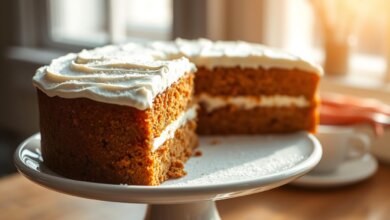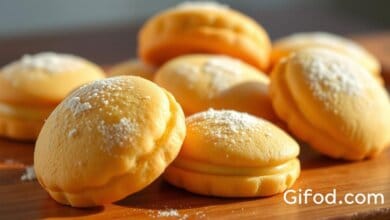Cheese and Stick: The Perfect Crunchy and Cheesy Snack Recipe 2025
What makes the perfect cheese and stick snack? Is it the crunchy texture and cheesy flavor? Or is there something more to this beloved snack? I’ll share my favorite cheese stick recipe that’s sure to satisfy your cravings.
With the right ingredients, like 1 3/4 cups of self-rising flour and 1/2 pound of sharp cheddar cheese, you’ll make the ultimate cheese and stick snack.

Whether you love spicy cheese sticks or prefer the classic version, this article will guide you. I’ll cover the essential ingredients and the best cooking methods. So, let’s start and explore the world of cheese and stick, perfect for any occasion.
Key Takeaways
- Learn the secret to making the perfect cheese and stick snack with a crunchy texture and cheesy flavor
- Discover the essential ingredients, including self-rising flour and sharp cheddar cheese, needed for a delicious cheese stick recipe
- Find out how to cook the perfect cheese and stick snack, whether you prefer baking or frying
- Get tips on how to customize your cheese stick recipe with different seasonings and ingredients
- Learn how to store your cheese and stick snacks to keep them fresh for up to a week
- Understand the nutritional information behind your cheese stick snack, including calories and protein content
- Explore different variations of the cheese and stick recipe, including spicy and classic options
The History Behind Cheese and Stick Snacks
Exploring cheese stick snacks reveals a fascinating history. These snacks have roots in ancient times, with cultures worldwide enjoying their own cheese sticks. In America, they’ve become a common snack, with many recipes and flavors available.
To make cheese sticks, you can use mozzarella or cheddar cheese. Pair it with crackers or bread for a quick snack.
The evolution of cheese stick snacks is a tale of innovation. The 1980s saw the rise of processed cheese snacks, changing how we enjoy them. Today, there’s a wide variety of cheesy stick appetizers. They’re perfect for a quick snack or a fun party appetizer.
Origins of Cheese Sticks
String cheese, the precursor to cheese sticks, emerged in the early 20th century in the U.S. It quickly became popular, becoming a staple by the 1960s. To make cheese sticks, try different cheeses and pair them with herbs or spices.
Evolution into Modern Snacking
Cheese sticks have evolved into a modern favorite. New brands like Handi-Snacks have expanded the market. Now, we have organic and gourmet options. Whether you seek a healthy snack or a fun treat, cheese sticks are a great choice.
Cultural Significance in American Cuisine
Cheese stick snacks are a big part of American cuisine. They’re enjoyed in many homes as a quick snack. Their popularity is evident in restaurants and food places offering cheesy stick appetizers. Learning about cheese stick snacks’ history helps us appreciate them more and find new ways to enjoy them.
Essential Ingredients for Perfect Cheese and Stick
To make the best cheese stick recipes, high-quality ingredients are key. The type of cheese is especially important. I suggest mixing sharp white Cheddar cheese with Parmigiano-Reggiano for the best taste.
Other must-haves include unbleached all-purpose flour, butter, and dried herbs and spices. You can adjust the cheese mix to your liking. But, start with ¼ cup sharp white Cheddar and 5 tablespoons Parmigiano-Reggiano.
Here are some key ingredients to keep in mind when making cheese sticks:
- High-quality cheese
- Unbleached all-purpose flour
- Butter
- Dried herbs and spices
Using these ingredients will help you make delicious cheese sticks. Whether you’re looking for the best recipes or just want to try new flavors, remember to use quality ingredients. And most importantly, have fun with it!
| Ingredient | Quantity |
|---|---|
| Sharp white Cheddar cheese | ¼ cup |
| Parmigiano-Reggiano cheese | 5 tablespoons |
| Unbleached all-purpose flour | 1 cup |
Kitchen Tools and Equipment You’ll Need
To make tasty homemade cheese sticks, you’ll need some basic kitchen tools. The right tools are key to making great cheese sticks. A food processor is crucial for mixing the cheese, and a rolling pin shapes it into sticks.
A baking sheet is needed to bake the cheese sticks until they’re golden brown. You might also want a pastry brush and cheese grater for extra steps. A digital thermometer helps control the temperature, ensuring the cheese is melted just right.
Other must-haves include a cutting board, knife, and spatula. With these, you’re ready to make delicious homemade cheese sticks. Whether you’re new to cooking or experienced, the right tools make a big difference in your cheese sticks’ quality.
Basic Equipment Requirements
- Food processor
- Rolling pin
- Baking sheet
- Pastry brush
- Cheese grater
Optional Tools for Advanced Preparation
- Digital thermometer
- Cutting board
- Knife
- Spatula
Selecting the Best Cheese for Your Sticks
Choosing the right cheese is key for a great cheese stick recipe. With many cheeses to pick from, it can be hard to decide. Recent taste tests show top picks like Kroger Mozzarella String Cheese, Good & Gather String Cheese, and Frigo Cheese Heads.
These cheeses offer different flavors and textures. Kroger Mozzarella String Cheese is creamy and smooth. Good & Gather String Cheese has a mild and creamy taste. Frigo Cheese Heads is the best for recipes, with a rich and tangy flavor.
When picking cheese for your cheese stick snacks, consider a few things:
- Flavor profile: Think about the flavor you want. Do you like it mild and creamy or rich and tangy?
- Texture: Decide on the texture you prefer. Do you want it soft and melty or firm and crunchy?
- Brand: Look into different brands to find the best one for you.
By thinking about these points and picking the right cheese, you can make the perfect cheese stick recipe. It will taste great and satisfy your cheese stick snacks cravings.
| Cheese Brand | Flavor Profile | Texture |
|---|---|---|
| Kroger Mozzarella String Cheese | Creamy and smooth | Soft and melty |
| Good & Gather String Cheese | Mild and creamy | Firm and crunchy |
| Frigo Cheese Heads | Rich and tangy | Soft and melty |
My Foolproof Cheese and Stick Recipe
To make the best cheese stick, use top-notch ingredients and a simple method. My recipe calls for 6 string cheese sticks, easily found in stores. I mix 1 cup of Panko breadcrumbs, 1 cup of seasoned breadcrumbs, and seasonings like garlic and onion powder for the coating.
This recipe takes about 30 minutes to 24 hours to prepare, depending on chilling time. Bake at 415°F for 10-20 minutes. Remember, the ideal frying temperature for mozzarella sticks is 365-370°F.
Preparation Time and Yields
This recipe yields 6 cheese sticks, with 435 kcal per serving. It has 42g of carbs, 21g of protein, and 20g of fat.
Step-by-Step Instructions
To make this recipe, follow these steps:
- Prepare the coating by mixing the breadcrumbs, seasonings, and eggs.
- Dip each cheese stick into the coating, making sure to coat it evenly.
- Place the coated cheese sticks on a baking sheet and bake for 10-20 minutes.
Critical Temperature Points
Remember the critical temperatures. Bake at 415°F and fry mozzarella sticks at 365-370°F.
This recipe is a top choice for cheese stick lovers. With the right ingredients and method, you’ll get crispy, melted cheese sticks.
| Nutritional Information | Per Serving |
|---|---|
| Calories | 435 kcal |
| Carbohydrates | 42g |
| Protein | 21g |
| Fat | 20g |
Tips for Achieving the Perfect Crunch
To make tasty cheese stick ideas a reality, focus on techniques that enhance crunch. A good coating is key. It adds flavor and crunch.
There are several coating methods to try. Double dredging coats the cheese stick in flour, eggs, and breadcrumbs. For a gluten-free option, use gluten-free panko breadcrumbs.
Coating Techniques
- Double dredging for an extra crunchy layer
- Using different types of breadcrumbs, such as panko, for a lighter crunch
- Experimenting with gluten-free options for those with dietary restrictions
Frying Methods
Frying is crucial for the perfect crunch. The ideal frying temperature is around 350°F. Make sure not to overcrowd the pot for even cooking.
It’s important to keep an eye on the oil temperature, especially when frying in batches.
| Method | Description |
|---|---|
| Frying | Ideal for achieving a golden, crispy coating |
| Baking | A healthier alternative that can still produce a satisfying crunch |
| Air Frying | Offers a balance between health and crunch, with less oil than traditional frying |
Mastering these techniques and trying different tasty cheese stick ideas will help you make homemade cheese sticks that are delicious and crunchy.
Common Mistakes to Avoid
Making cheese sticks can be tricky. To get it right, follow the best recipes and techniques. Don’t overwork the dough, as it can make the snack tough. Also, using low-quality cheese can ruin the flavor and melting.
Experts say controlling the temperature is key. Avoid high heat to prevent burnt cheese or uneven cooking. Use medium heat and adjust it as needed. Here are some tips to avoid common problems:
- Choose high-quality cheese, like gouda or cheddar, for better flavor.
- Don’t overwork the dough. Instead, fold and shape it gently.
- Keep the temperature in check for the perfect melt.
By avoiding these mistakes, you can make tasty cheese sticks. Try different cheese blends and techniques to find your favorite. With practice, you’ll soon be a pro at making cheese sticks.
| Mistake | Tip |
|---|---|
| Overworking the dough | Gentle folding and shaping |
| Using low-quality ingredients | High-moisture cheese, such as gouda or cheddar |
| High heat | Medium heat, adjust as needed |
Creative Variations and Flavoring Options
There are countless ways to make cheese stick snacks. Try adding spices like paprika or garlic powder for a new taste. For example, mix cheddar and parmesan with paprika for a smoky flavor.
Customize your cheese sticks with different cheese blends. A mix of mild cheddar, blue cheese, and goat cheese is tangy and rich. You can also pair cheese with pretzel or breadsticks for a crunchy bite.
Coating Alternatives
Explore other coatings for your cheese stick snacks. Options include:
- Pretzel rods
- Crackers
- Crostoni
- Even crispy snack chips like Fritos or Doritos
These coatings can make your cheesy stick appetizers unique. They’re great for any event, from a quick snack to a party favorite.
Be creative with flavors and coatings to make your own cheese stick snacks. Your taste buds will love it! So, don’t hesitate to try new things.
Serving and Storage Recommendations
When serving and storing homemade cheese sticks, a few tips can help keep them fresh. Cheeses should be at room temperature for the best taste. Soft cheeses need about 30 minutes to warm up, while semi-firm and hard cheeses should rest for at least an hour.
For storing, wrap cheese sticks in a breathable material like cheese paper or parchment. Reusable wraps like Bee’s Wrap are also a good choice for the environment. Wrapping wrong can dry out the cheese, wasting it and costing more.
Here are some storage tips:
- Keep cheese in the fridge at a temperature below 40°F (4°C).
- Use a cheese storage container, like the Cheese Grotto, for the right humidity and temperature.
- Don’t freeze fresh, moist cheeses as it changes their texture a lot.
By following these tips, you can enjoy your homemade cheese sticks longer and keep them tasting great.

| Storage Method | Cost | Duration |
|---|---|---|
| Cheese Paper | $0.60 per sheet | 1-2 uses |
| Reusable Food Wraps (Bee’s Wrap) | $6 per sheet | 1-2 months |
| Cheese Grotto | $85 (one-time purchase) | Lifetime |
Nutritional Information and Dietary Considerations
When looking at cheese and stick snacks, it’s key to think about their nutrition and how they fit into your diet. A single ounce of hard cheese has about 120 calories, 8 grams of protein, 6 grams of saturated fat, and 180 milligrams of calcium.
Here is a breakdown of the nutritional content of various cheeses:
| Cheese Type | Calories | Protein | Saturated Fat | Sodium |
|---|---|---|---|---|
| Brie | 95 | 7.9g | 6g | 8% DV |
| Cheddar | 114 | 6.4g | 9.4g | 8% DV |
| Feta | 75 | 4g | 6.1g | 14% DV |
Different cheeses have different amounts of calories, protein, saturated fat, and sodium. It’s important to pay attention to these when eating cheese stick snacks. This helps you make better choices for your diet.
In moderation, cheese and stick snacks can fit into a healthy diet. But, it’s important to think about the nutrition and how it affects your health. This ensures you live a balanced and healthy life.
Conclusion: Mastering Your Homemade Cheese and Stick Creation
As we wrap up our cheese and stick adventure, I urge you to explore and experiment. This snack is all about endless possibilities for making it your own. By following the steps in this article, you can create your own special cheese sticks that will make your taste buds happy.
Remember, the secret to making the best cheese sticks is to keep trying and be patient. Try different cheeses, spices, and coatings to find your favorite flavor. Don’t be scared to mix things up – sometimes the best surprises come from unexpected combinations.
Keep making cheese sticks and use the tips and facts from this article to guide you. Aim for the right temperature and humidity, and let the cheese’s natural process work its magic. With a bit of practice, you’ll get that perfect crunchy, cheesy texture every time.
So, pick your favorite cheese, preheat the oven, and let your creativity run wild. Making homemade cheese sticks is not just tasty; it shows off your cooking skills. Enjoy making them, relish the taste, and share them with loved ones. Happy snacking!
FAQ
What is the history behind cheese and stick snacks?
Cheese sticks have a long history, starting in traditional European cuisine. They became a favorite snack in America, loved for their crunchy outside and cheesy inside.
What are the essential ingredients needed to make the perfect cheese and stick?
To make great cheese sticks, you need good cheese (like cheddar, mozzarella, or parmesan), butter, flour, and spices. These add to the flavor.
What kitchen tools and equipment are required to make cheese sticks?
You’ll need a food processor, rolling pin, and baking sheets. A pastry brush and cheese grater can make things easier too.
How do I select the best cheese for my cheese sticks?
Pick cheese based on flavor, melting, and texture. Cheddar, mozzarella, and parmesan are great choices for different tastes and textures.
Can you provide a foolproof cheese and stick recipe?
Yes! My recipe has easy steps, prep time, and how many you’ll get. It also has important temperature tips for perfect cheese sticks.
How can I achieve the perfect crunch for my cheese sticks?
For the perfect crunch, try different coatings and frying or baking methods. Keeping the right temperature is key.
What are some common mistakes to avoid when making cheese sticks?
Avoid using bad ingredients, overworking the dough, and not controlling the cooking temperature. These mistakes can ruin your cheese sticks.
Can I customize the flavor of my cheese sticks?
Yes! Mix different spices, cheeses, and coatings to make your own unique cheese sticks. It’s all about your taste.
How should I store and serve my homemade cheese sticks?
Keep your cheese sticks fresh by storing them right. Try different ways to serve and dip them for the best taste.
What are the nutritional considerations for cheese sticks?
Cheese sticks can be tasty but watch the calories and fat. With some planning, they can be part of a healthy diet.



